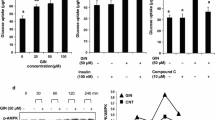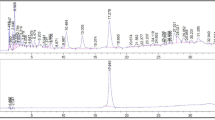Abstract
Previous studies have demonstrated antidiabetic effects for rooibos (Aspalathus linearis) and aspalathin (ASP), one of its main polyphenols. Rooibos, an endemic plant of South Africa, is well-known for its use as herbal tea. Green (‘unfermented’) rooibos has been shown to contain more ASP than ‘fermented’ rooibos tea, currently the major product. In the present study, we investigated the antidiabetic effect of green rooibos extract (GRE) through studies on glucose uptake in L6 myotubes and on pancreatic β-cell protective ability from reactive oxygen species (ROS) in RIN-5F cells. Its in vivo effect was also examined using obese diabetic KK-Ay mice. GRE increased glucose uptake under insulin absent condition and induced phosphorylation of 5′-adenosine monophosphate-activated protein kinase (AMPK) in L6 myotubes as previously demonstrated for ASP. In addition to AMPK, GRE also promoted phosphorylation of Akt, another promoter of glucose transporter 4 (GLUT4) translocation, in L6 myotubes unlike ASP, suggesting an involvement of GRE component(s) other than ASP in Akt phosphorylation. Promotion of GLUT4 translocation to the plasma membrane by GRE in L6 myotubes was demonstrated by Western blotting analysis. GRE suppressed the advanced glycation end products (AGEs)-induced increase in ROS levels in RIN-5F pancreatic β-cells. Subchronic feeding with GRE suppressed the increase in fasting blood glucose levels in type 2 diabetic model KK-Ay mice. These in vitro and in vivo results strongly suggest that GRE has antidiabetic potential through multiple modes of action.




Similar content being viewed by others
Abbreviations
- AGEs:
-
Advanced glycation end products
- AMPK:
-
5′-Adenosine monophosphate-activated protein kinase
- ASP:
-
Aspalathin
- GLUT4:
-
Glucose transporter 4
- GRE:
-
Green rooibos extract
- HPLC:
-
High performance liquid chromatography
- PPAG:
-
Phenyl pyruvic acid-2-O-β-glucoside
- QROB:
-
Quercetin-3-O-robinobioside
- ROS:
-
Reactive oxygen species
- SB1:
-
Solvent-based aspalathin-enriched green rooibos extract
- STZ:
-
Streptozotocin
References
Alderman MH, Cohen H, Madhavan S (1999) Diabetes and cardiovascular events in hypertensive patients. Hypertension 33:1130–1134
Beelders T, Sigge GO, Joubert E, de Beer D, de Villiers A (2012a) Kinetic optimisation of the reversed phase liquid chromatographic separation of rooibos tea (Aspalathus linearis) phenolics on conventional high performance liquid chromatographic instrumentation. J Chromatogr A 1219:128–139
Beelders T, Kalili K, Joubert E, de Beer D, de Villiers A (2012b) Comprehensive two-dimensional liquid chromatographic analysis of rooibos (Aspalathus linearis) phenolics. J Sep Sci 35:1808–1820
Bucala R, Vlassara H (1995) Advanced glycosylation end products in diabetic renal and vascular disease. Am J Kidney Dis 26:875–888
Cai E, Lin J-K (2009) Epigallocatechin gallate (EGCG) and rutin suppress the glucotoxicity through activating IRS2 and AMPK signaling in rat pancreatic β cells. J Agric Food Chem 57:9817–9827
Cheong SH, Furuhashi K, Ito K, Nagaoka M, Yonezawa T, Miura Y, Yagasaki K (2014a) Antihyperglycemic effect of equol, a daidzein derivative, in cultured L6 myocytes and ob/ob mice. Mol Nutr Food Res 58:267–277
Cheong SH, Furuhashi K, Ito K, Nagaoka M, Yonezawa T, Miura Y, Yagasaki K (2014b) Daidzein promotes glucose uptake through glucose transporter 4 translocation to plasma membrane in L6 myocytes and improves glucose homeostasis in Type 2 diabetic model mice. J Nutr Biochem 25:136–143
Fiorentino TV, Prioletta A, Zuo P, Folli F (2013) Hyperglycemia-induced oxidative stress and its role in diabetes mellitus related cardiovascular diseases. Curr Pharm Des 19:5695–5703
Fisher JS, Gao J, Han DH, Holloszy JO, Nolte LA (2002) Activation of AMP kinase enhances sensitivity of muscle glucose transport to insulin. Am J Physiol Endocrinol Metab 282:E18–E23
Genuth S, Alberti KG, Bennett P, Buse J, Defronzo R, Kahn R, Kitzmiller J, Knowler WC, Lebovitz H, Lernmark A, Nathan D, Palmer J, Rizza R, Saudek C, Shaw J, Steffes M, Stern M, Tuomilehto J, Zimmet P, Expert Committee on the Diagnosis and Classification of Diabetes Mellitus (2003) Follow-up report on the diagnosis of diabetes mellitus. Diabetes Care 26:3160–3167
Ha BG, Nagaoka M, Yonezawa T, Tanabe R, Woo JT, Kato H, Chung UI, Yagasaki K (2012) Regulatory mechanism for the stimulatory action of genistein on glucose uptake in vitro and in vivo. J Nutr Biochem 23:501–509
Hammes HP, Alt A, Niwa T, Clausen JT, Bretzel RG, Brownlee M, Schleicher ED (1999) Differential accumulation of advanced glycation end products in the course of diabetic retinopathy. Diabetologia 42:728–736
Hernández-Mijares A, Bañuls C, Peris JE, Monzó N, Jover A, Bellod L, Victor VM, Rocha M (2013) A single acute dose of pinitol from a naturally-occurring food ingredient decreases hyperglycaemia and circulating insulin levels in healthy subjects. Food Chem 141:1267–1272
Huang S, Czech MP (2007) The GLUT4 glucose transporter. Cell Metab 5:237–252
Iglesias MA, Ye JM, Frangioudakis G, Saha AK, Tomas E, Ruderman NB, Cooney GJ, Kraegen EW (2002) AICAR administration causes an apparent enhancement of muscle and liver insulin resistant high-fat-fed rats. Diabetes 51:2886–2894
Joubert E (1996) HPLC quantification of the dihydrochalcones, aspalathin and nothofagin in rooibos tea (Aspalathus linearis) as affected by processing. Food Chem 55:403–411
Joubert E, Manley M, Botha M (2008) Evaluation of spectrophotometric methods for screening of green rooibos (Aspalathus linearis) and green honeybush (Cyclopia genistoides) extracts for high levels of bio-active compounds. Phytochem Anal 19:169–178
Kaneto H, Katakami N, Matsuhisa M, Matsuoka TA (2010) Role of reactive oxygen species in the progression of type 2 diabetes and atherosclerosis. Mediat Inflamm 2010:453892
Kawano A, Nakamura H, Hata S, Minakawa M, Miura Y, Yagasaki K (2009) Hypoglycemic effect of aspalathin, a rooibos tea component from Aspalathus linearis, in type 2 diabetic model db/db mice. Phytomedicine 16:437–443
Kume S, Kato S, Yamagishi S, Inagaki Y, Ueda S, Arima N, Okawa T, Kojiro M, Nagata K (2005) Advanced glycation end-products attenuate human mesenchymal stem cells and prevent cognate differentiation into adipose tissue, cartilage, and bone. J Bone Miner Res 20:1647–1658
Lenzen S, Drinkgern J, Tiedge M (1996) Low antioxidant enzyme gene expression in pancreatic islets compared with various other mouse tissues. Free Radic Biol Med 20:463–466
Mazibuko SE, Muller CJF, Joubert E, de Beer D, Johnson R, Opoku AR, Louw J (2013) Amelioration of palmitate-induced insulin resistance in C2C12 muscle cells by rooibos (Aspalathus linearis). Phytomedicine 20:813–819
Mendis E, Kim MM, Rajapakse N, Kim SK (2007) An in vitro cellular analysis of the radical scavenging efficacy of chitooligosaccharides. Life Sci 80:2118–2127
Minakawa M, Kawano A, Miura Y, Yagasaki K (2011) Hypoglycemic effect of resveratrol in type 2 diabetic model db/db mice and its actions in cultured L6 myotubes and RIN-5F pancreatic β-cells. J Clin Biochem Nutr 48:237–244
Minakawa M, Miura Y, Yagasaki K (2012) Piceatannol, a resveratrol derivative, promotes glucose uptake through glucose transporter 4 translocation to plasma membrane in L6 myocytes and suppresses blood glucose levels in type 2 diabetic model db/db mice. Biochem Biophys Res Commun 422:469–475
Muller CJF, Joubert E, de Beer D, Sanderson M, Malherbe CJ, Fey SJ, Louw J (2012) Acute assessment of an aspalathin-enriched green rooibos (Aspalathus linearis) extract with hypoglycemic potential. Phytomedicine 20:32–39
Muller CJF, Joubert E, Pheiffer C, Ghoor S, Sanderson M, Chellan N, Fey SJF, Louw J (2013) Z-2-(β-d-glucopyranosyloxy)-3-phenylpropenoic acid, an α-hydroxy acid from rooibos (Aspalathus linearis) with hypoglycemic activity. Mol Nutr Food Res 57:2216–2222
Nishiumi S, Ashida H (2007) Rapid preparation of a plasma membrane fraction from adipocytes and muscle cells: application to detection of translocated glucose transporter 4 on the plasma membrane. Biosci Biotechnol Biochem 71:2343–2346
Ojuka EO (2004) Role of calcium and AMP kinase in the regulation of mitochondrial biogenesis and GLUT4 levels in muscle. Proc Nutr Soc 63:275–278
Rabe C, Steenkamp JA, Joubert E, Burger JFW, Ferreira D (1994) Phenolic metabolites from rooibos tea (Aspalathus linearis). Phytochemistry 35:1559–1565
Robertson RP, Zhou H, Zhang T, Harmon JS (2007) Chronic oxidative stress as a mechanism for glucose toxicity of the beta cell in Type 2 diabetes. Cell Biochem Biophys 48:139–146
Sakamoto K, McCarthy A, Smith D, Green KA, Grahame Hardie D, Ashworth A, Alessi DR (2005) Deficiency of LKB1 in skeletal muscle prevents AMPK activation and glucose uptake during contraction. EMBO J 24:1810–1820
Saltiel AR, Kahn CR (2001) Insulin signaling and the regulation of glucose and lipid metabolism. Nature 414:799–806
Sezik E, Aslan M, Yesilada E, Ito S (2005) Hypoglycaemic activity of Gentiana olivieri and isolation of the active constituent through bioassay-directed fractionation techniques. Life Sci 76:1223–1238
Snijman PW, Joubert E, Ferreira D, Li X-C, Ding Y, Green IR, Gelderblom WCA (2009) Antioxidant activity of the dihydrochalcones aspalathin and nothofagin and their corresponding flavones in relation to other rooibos (Aspalathus linearis) flavonoids, epigallocatechin gallate, and Trolox. J Agric Food Chem 57:6678–6684
Son MJ, Minakawa M, Miura Y, Yagasaki K (2013) Aspalathin improves hyperglycemia and glucose intolerance in obese diabetic ob/ob mice. Eur J Nutr 52:1607–1619
Tan KC, Shiu SW, Wong Y, Tam X (2011) Serum advanced glycation end products (AGEs) are associated with insulin resistance. Diabetes Metab Res Rev 27:488–492
Tiedge M, Lortz S, Drinkgern J, Lenzen S (1997) Relation between antioxidant enzyme gene expression and antioxidative defense status of insulin-producing cells. Diabetes 46:1733–1742
Towler MC, Hardie DG (2007) AMP-activated protein kinase in metabolic control and insulin signaling. Circ Res 100:328–341
Verdecchia P, Reboldi G, Angeli F, Borgioni C, Gattobigio R, Filippucci L, Norgiolini S, Bracco C, Porcellati C (2004) Adverse prognostic significance of new diabetes in treated hypertensive subjects. Hypertension 43:963–969
Wautier JL, Guillausseau PJ (2001) Advanced glycation end products, their receptors and diabetic angiopathy. Diabetes Metab 27:535–542
Wild S, Roglic G, Green A, Sicree R, King H (2004) Global prevalence of diabetes: estimates for the year 2000 and projections for 2030. Diabetes Care 27:1047–1053
Yagasaki K, Morisaki N, Kitahara Y, Miura A, Funabiki R (2003) Involvement of protein kinase C activation in l-leucine-induced stimulation of protein synthesis in L6 myotubes. Cytotechnology 43:97–103
Acknowledgments
This work was supported by grants to K. Y. and Y. M. from the Japan Society for the Promotion of Science (JSPS) and by grants to E. J. from the National Research Foundation of South Africa (NRF) under the NRF/JSPS (SA/Japan) Scientific Cooperation Agreement. NRF grant holder (E.J.) acknowledges that opinions, findings and conclusions or recommendations expressed in any publication generated by the NRF supported research (Grants 75425 and 85105) are those of the authors, and that the NRF accepts no liability whatsoever in this regard.
Conflict of interest
The authors declare that they have no conflict of interest.
Author information
Authors and Affiliations
Corresponding author
Rights and permissions
About this article
Cite this article
Kamakura, R., Son, M.J., de Beer, D. et al. Antidiabetic effect of green rooibos (Aspalathus linearis) extract in cultured cells and type 2 diabetic model KK-Ay mice. Cytotechnology 67, 699–710 (2015). https://doi.org/10.1007/s10616-014-9816-y
Received:
Accepted:
Published:
Issue Date:
DOI: https://doi.org/10.1007/s10616-014-9816-y




